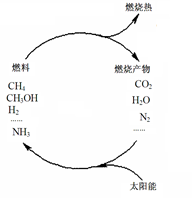(9分)为解决过度使用化石燃料造成的能源危机及环境问题,科学家提出如下
图构想:

(1)水在催化剂和光照条件下分解可制得氢气,写出该反应的化学方程
式: 。
(2)垃圾中的有机物发酵得到沼气,写出沼气的主要成分燃烧的化学方程式: 。
(3)科学家设想以燃烧产物中的CO2合成燃料CH3OH,这一反应可以缓解的环境问题是 。
(4)氨气可在不同条件下与氧气反应生成不同的产物,且放出大量的热。若从环保角度考虑,氨气与氧气反应生成理想的产物是 和 。
(9分)
光照 |
(2)CH4 + 2O2 点燃 CO2 + 2H2O 。
(3)温室效应(或酸雨等合理答案)。
(4)H2O和N2(或 “水和氮气”,顺序可调换)。
:(1)水在催化剂和光照条件下分解可制得氢气,反应的化学方程式为2H2O 催化剂 2H2 ↑+O2 ↑ 。
(2)沼气的主要成分是甲烷,燃烧生成二氧化碳和水,反应的化学方程式为CH4 + 2O2 点燃 CO2 + 2H2O 。
(3)二氧化碳的增多,能使全球气候变暖,造成温室效应,以燃烧产物中的CO2合成燃料CH3OH,这一反应可以缓解温室效应;
(4)水不污染环境,氮气是空气的主要成分,也不污染空气,所以氨气与氧气反应生成理想的产物是H2O和N2.
故答案为:
光照 |
(2)CH4 + 2O2 点燃 CO2 + 2H2O 。
(3)温室效应(或酸雨等合理答案)。
(4)H2O和N2(或 “水和氮气”,顺序可调换)。
